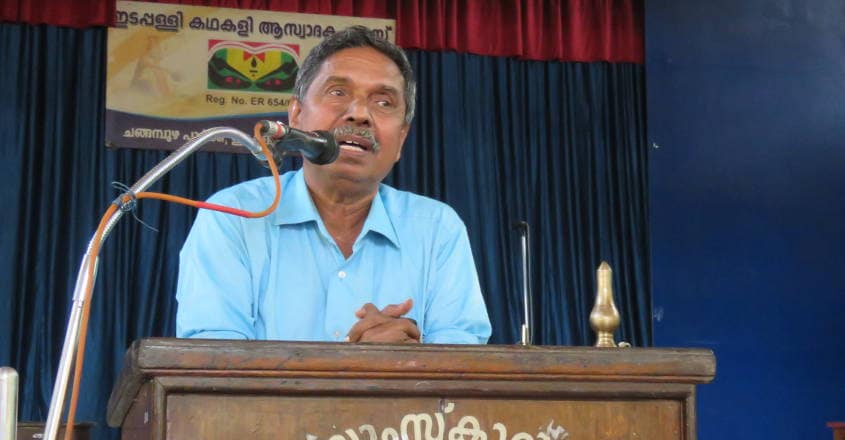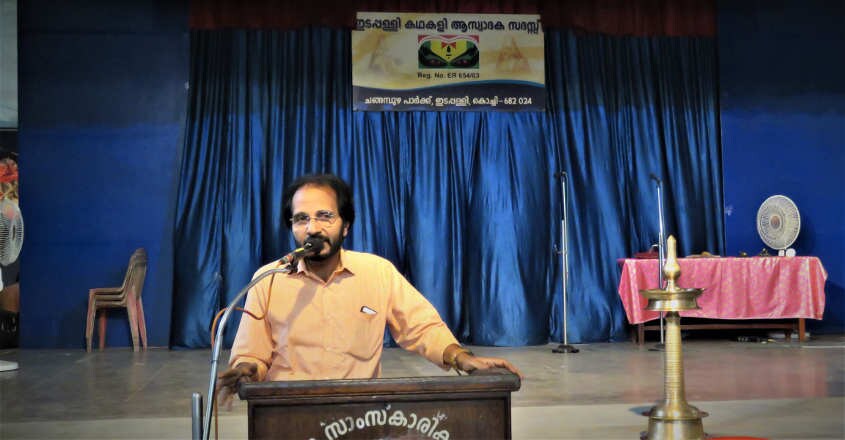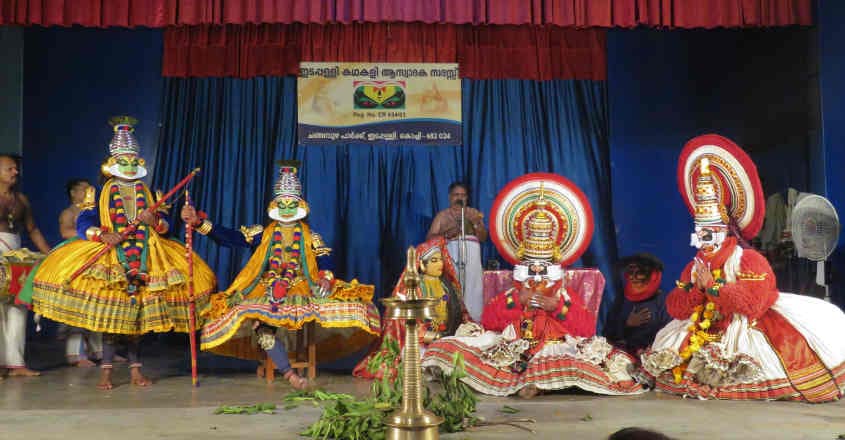How Kathakali is countering new-age challenges and reinventing itself

Mail This Article
Kochi: The vocal music for Kathakali is tending towards standardisation in tune with time even as buffs of the classical dance-drama are largely indifferent to new story-plays and continue to be plagued with gender bias, a three-day mega performance event noted.
Seminars in all three evenings of the 2019 annual festival of the Edappally Kathakali Aswadaka Sadas last week focused on contemporary trends in various segments of the traditional Kerala art-form, while taking a brief stock of its 400-year history. The future can be bright, provided certain reorientation happens from not just the artistes but aesthetes as well, going by the scholars at the January 23-25 Kathakali Mahotsavam held at Edappally, 15 km north of this city.
Kathakali, with its origin in the feudal era, is yet again going through a major churning amid fast changes in the socioeconomic scenario that has been evidently altering the ballet’s body and spirit, according to the speakers at the symposia held in Changampuzha Park. The 16th edition of the festival also hosted three Kathakali shows featuring top artistes besides lecture-demonstrations that introduced the audience to the stories of the evening.

The colloquium series concluded on Friday with a lecture on the background vocals of the indigenous theatre at a time when its practitioners are getting greater exposure to other forms alongside steadily improving acoustics. There is less of individualism among the present-generation singers vis-à-vis the 20th-century masters, whose music nonetheless shows signs of resonating for decades to come, as per ‘Kathakali Music: Yesterday, Today, Tomorrow’.
Critic-author V Kaladharan, addressing the session, recalled that iconic Kathakali musicians who rose in the 1960s and ’70s owned a style that sought to convey a one-on-one intimacy with each listener. “That is getting diluted of late. Today, it’s more of a rendition that goes smooth throughout the show but seldom turns out to be an individualistic expression,” he said, contrasting it with the heyday of an array of disciples of epoch-defining Kalamandalam Neelakantan Nambisan, who redefined Kathakali music since mid-20th century.
While Nambisan’s gurus, primarily Mundaya Venkitakrishna Bhagavatar and Kavassery Samikutty, did sow the first seeds of revolution in Kathakali music a 100 years ago, Nambisan (1919-85) took the spirit further forward at the famed institution of Kalamandalam in central Kerala. The result was a legion of pupils, quite a few of whom went on to embellish the idiom in varied ways and taste. The harbinger among them was Sankaran Embranthiri, said Kaladharan, soon followed by the arrival of Unnikrishna Kurup after a nondescript stint in eastern India.

While Embranthiri revelled in oscillatory gamakas, Kurup’s music was free from microtones thereby revealing the beauty of plain notes. Kalamandalam Gangadharan, another prominent disciple of Nambisan, banked more on the aesthetic of Carnatic music, but a throat rupture cut short the initial robustness of his voice. To tread more romantic ways were Kalamandalam Hyderali and Venmani Haridas, said Kaladharan, who writes extensively on Indian classical music and dances.
The speaker, who served Kalamandalam office in Cheruthuruthy near Shoranur for three decades before retiring as a superintendent, noted that Travancore had its 20th-century music masters in Cherthala Kuttappa Kurup and Neelakantan Unnithan. Recalling a Behag-raga piece in a Kuttappa Kurup record that exemplified his excellence, Kaladharan said Unnithan, all the same, wasn’t particularly impressive, going by anecdotes from Gangadharan (who hailed from southern Travancore).

“Among the more authentic voices I could hear from the southern wing of Kathakali music is that of Thakazhi Kuttan Pillai,” the speaker said, hailing the vocalist’s care for enunciating the lyrics and keeping the right rhythm. “With him was Thanneermukkom Viswambharan, more appealing, but then his life didn’t last that long.”
Contextually, Kaladharan recalled a “polarisation” that existed in Travancore’s music scene even till the 1970s, when Kathakali vocalists sang “monochrome” and the region had Carnatic masters celebrated in a big way. The result was temple festivals those days had classical vocalists from neighbouring Tamil Nadu giving milestone concerts starting late evening, while the night-long Kathakali on the same stage sounded feeble with its set of “ordinary” musicians.
What boosted Kathakali music in central Kerala (often referred as ‘north’ in Kathakali parlance) was its infusion of elements from Carnatic, thanks to Venkitakrishna Bhagavathar, whose Brahmin family had migrated from the Cauvery belt around Thanjavur. Bhagavathar, who lived (1881-57) in Mundaya village, was called to Kalamandalam the other side of the Bharatapuzha river to revamp Kathakali music in the 1940s. Three decades later, his disciple Nambisan’s frontline pupil Embranthiri was to “conquer” the Kathakali music scene in Travancore, pointed out Kaladharan, basing his talk on the guess that Kathakali music in the 19th century and before could largely be based on Kerala's temple-allied Sopanam music.

Today, popular musicians Pathiyur Sankarankutty and Kottakkal Madhu grace the Kathakali stage with soothing music, though not with much of a special care to embellish a particular raga and scene. “Yet in all of the present lot, one can sense closer and farther echoes of a bygone musical system,” Kaladharan said. “The younger among the current stock are “definitely talented”, though most of them have to pay greater attention to the literary merit of what they sing.”
The January 24 seminar had scholar Dr P Venugopal speaking on Kathakali plays that have been conceived (and staged) in the past half a century. The speaker said innovative devices in narrative can make ‘old’ stories look fresh; so there was perhaps no need to experiment with plots that don’t exist in Kathakali or Indian mythology that is conventionally the thematic resource of the art-form.
Even existing Kathakali stories can be retold in different ways, thus dishing out a different experience for the viewer, he added in his talk on ‘Relevance of New Kathakali Stories’. For instance, the classical story-play of 'Kirmeeravadham' (The Slaying of Kirmeera) can be presented anew if it departs from the Kalluvazhi style set strong by 20th-century Kathakali maestro Pattikamthodi Ravunni Menon.
Some of the new Kathakali stories deserve more stages as “good” experiments, the speaker said, listing Sadanam Harikumaran’s ‘Sapamochanam’ and Vaikom Rajashekhar’s ‘Arjuna Vishadavrittam’ among them. Two of last century’s productions, ‘Bheemabandhanam’ by all-round artist Kalamandalam Keshavan and ‘Bhishmasapatham’ by his encyclopaedic guru Krishnankutty Poduval, merit rework and an entry in the Kathakali classrooms. “Art enthusiasts should not ignore these two works,” added the scholar, who has penned ‘Krishnaleela’ (Bhagavata story of the 'Puranas') and ‘Don Quixote’ (based on the eponymous Spanish novel of early 17th century) for Kathakali stages to reasonable success.

‘Karnasapatham’, for all its ‘poor’ literature and presentational ‘defects’, continues to be the most popular among new plays in Kathakali, where some of the youngest crop of scripters show promise in the subject, added Dr Venugopal, a retired Malayalam professor from the University of Kerala.
At the festival’s opening evening on January 23, researcher-artist Haripriya Nambudiri lamented that Kathakali aficionados rarely encourage female artists in Kathakali that has been a male preserve since its birth. In her speech titled ‘Female Representation in Kathakali’ at the discussion moderated by septuagenarian scholar Dr K G Paulose, the artist protested “over-glorifying” the rigorous monsoon-months oil-massage that has traditionally been a body-strengthening exercise helping energy conservation and deployment during performance.
The speaker found support from fellow artiste Parvathy Menon, who said it was wrong on the part of the state’s premier institutes to bar women learning Kathakali as full-time students. This, after young dancer Kalamandalam Adithyan sought to justify his school’s ‘norms’ even while welcoming greater presence of females in Kathakali.

The festival had three Kathakali shows: 'Nalacharitham Onnam Divasam' (January 23), 'Vichhinnabhishekam' (Jan 24) and 'Balivadham' (Jan 25). The masters included Kalamandalam Gopi, Margi Vijayakumar, Kalamandalam Balasubramanian, Sreekumar, Soman, Kottakkal Devadas, Peesappilly Rajeevan, Champakara Vijayakumar, Arun Warrier and Kalamandalam Neeraj (actor-dancers), Pathiyur Sankarankutty, Kottakkal Narayanan, Kalamandalam Babu Namboothiri, Harish Namboodiri, Kalanilayalam Rajeevan, Nedumbilly Rammohan (vocal), Kalamandalam Unnikrishnan, Raman Namboodiri, Kalamandalam Krishnadas, Achutha Warier, Kalanilayam Manoj and Kalamandalam Rajnarayanan (percussion) and Kalamandalam Satheesan, Kalanilayam Saji and Eroor Manoj (make-up). The costume sets were from Bhavaneeswaram Kaliyogam near Tripunithura, south of Kochi.
(With inputs from Prasad Govindapuram)

